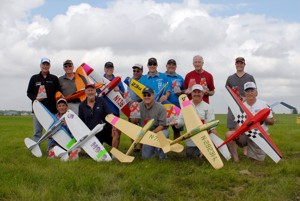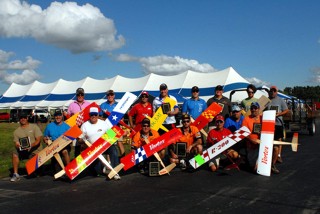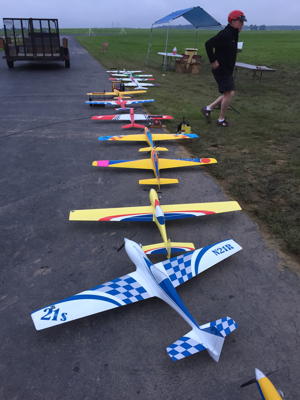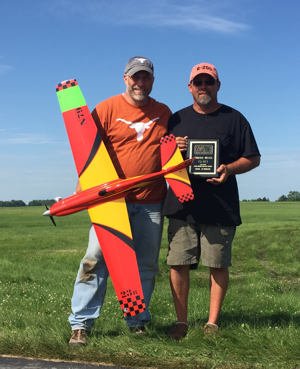Now that the smoke has cleared and I’ve recovered from my trip to the AMA Pylon National Championships held during the week of July 10-16 at the International Aeromodelling Center in Muncie, IN, I can think back about all the great action and present my account. While this “week of speed” included Club 40 (for the first time!) and AMA 424 classes, I didn’t arrive until they were completed. I trust that they will be covered elsewhere. But I was present for the rest of the week and personally joined the battle in the AMA 426 (Super Sport Quickee) and AMA 422 (Q40) classes. And I also enjoyed the intense action of the yet unofficial EF-1 class that ran during our airframe safety inspection day on the first Sunday, July 12.
EF-1 is the newest racing class that has been introduced by the pylon special interest group, NMPRA, in an effort to get more people interested in competitive racing. It’s the only class to feature electric-power using stock hardware and thus eases the perceived need to be an “engine guru” to be competitive. There are also quite a number of cool and fast ARF’s available to get one involved with minimal effort. The final results after the six round event are presented here. And be sure to check out the fantastic photos from this and all the racing classes on the AMA Pylon NATS Flickr page.

2015 Champion Jerry Small (front row - 2nd from left) and the rest of the EF-1 NATS winners. Photo credit – Santiago Panzardi
Congrats go out to Texan Jerry Small who is the 2015 EF-1 National Champion flying his co-designed (with Dan Kane) “Estrellita”. These two are also main players in the creation and development of the EF-1 class! And I’m also particularly proud of my good friends and fellow AMA District IV members Mike Langlois and Jim Katz who placed third and sixth (with fast time), respectively, with Jim’s own designed and built “Sweet Pea” racers. As you can see in the photo, there are some really cool aircraft in use here. And five of the top ten raced ARF’s. So don’t be afraid to jump in and give it a try.
The AMA 426 or Super Sport Quickee class features the usual 500 square-inch, constant chord-winged aircraft most are familiar with. And the spec engine is the stock Quickee-Jett 40. While the faster EF-1 aircraft do about 125 mph on a shorter course, 426 aircraft do roughly 150-160 mph on the so-called “AMA short course”. This and all pylon racing regulations and course layouts can be found in the AMA competition rules.
Since there were 72 registered pilots in the 426 class, the field was evenly broken down into two groups. Each group raced through 6 qualifying heats and the top twelve plus the two fastest (not already qualified) race times from each transferred into a five round final. I’ve noticed that the competition level in this class has been steadily improving to the point where there are no easy heat races! So how did I do? Well, I finished second in my first two heats but then tangled with my friend and fellow NC pylon racer, Dean Stone, in round three and crashed my primary plane. My backup didn’t get the job done for me after that (that’s my excuse and I’m sticking with it) and I missed the cut to the finals.

The 2015 Super Sport Quickee National Champion, Marcus Blanchard (front row, center) and the rest of the top ten at the 2105 AMA Pylon NATS. Photo by Bob Hunt
I later remarked to someone that “if there was ever I final I didn’t mind missing, this was it”. That was because, not only was it very exciting to watch, but the wind was so strong that it really challenged the pilots and some didn’t win. Let me tell you that those who survived this race really earned it. When it all shook out, Marcus Blanchard from SC emerged as the 2015 AMA 426 National Champion. He was blazingly fast, led through all five rounds, and handled the wind like a pro! The rest of the 426 finals standing can be seen here. And don’t forget the great pictures from the AMA in the link above, which includes tons of action shots from this class, too. Again, I have to give a “shout out” to a fellow District IV racer, Joe Hodgin, who placed 10th with the help of caller, Dean Stone.
The “top fuel” class of RC pylon racing, at least in speed, is AMA 422 or the Quarter-40 (Q40) class. Here, pilots must fly approved versions of full-scale race aircraft with most designs replicating cool F-1 or Unlimited Reno racers. These composite speedsters look fast sitting on the runway but prove it on the race course with speeds near 200 mph on the straights! The engines come from one of two approved US suppliers; Aero Racing Engines (Nelson LS Q40) or Jett Engineering (Jett LS Q40) and make nearly 3.5 hp with just a 0.40 cu. in. displacement at over 28,000 rpm in the air. It’s the epitome of performance and speed that leads to extremely exhilarating racing action for pilots and spectators alike.
Like the 426 class, Q40 had a large number of pilots (62) that required a similar “split qualifying group” format. And when you fly in Q40 at the NATS, you work hard for every point in the eight qualifying rounds to earn a spot as one of the 28 in the finals. I was flying my new AR-6 design that only had about five practice flights on it prior to the event. After some pre-race test flight adjustments, it was working pretty well and I jumped right into some intense action. While I wasn’t flying up to the potential of the aircraft (practice makes perfect, right?) I did manage a first, three seconds and a third after five rounds (with the great help of my teammate and caller, Joe Rafalowski, who was also fast) and was sitting comfortably in “finals territory”. But as in any high-level competition, you can’t count your chickens….well, you know. In round six, I got greedy on my needle valve setting and had to struggle around the 10 laps with a lean run as everyone smoked by me and I ruined my motor. I had a backup engine, but that loss of three precious points was my ultimate demise. I ended up missing the finals by one point! You have to be completely on your game in big-league racing and I didn’t quite deliver. But did I have have fun? YES!
Enough about me. The race did go on and the action was fantastic. All of my Old Julian Airport racing buddies from District IV made the finals and were fast: Mike Langlois, Jim Katz, Dean Stone, Trey Witte, John McDermott, and Joe Hodgin. Likewise for our bud, Steve Baker, from MD. Since I wasn’t racing in the finals, I managed to shoot phone videos of a race start and the pilots /callers during a heated race to give you some first-hand perspective. When the dust settled after a five-round final, the results were tallied here. Jim Allen continued his hot streak and added “2015 NATS Q40 Champion” to his list of accomplishments! Jim and the rest of the top ten pilots can bee seen in the article header photo above. Aren’t those aircraft colorful and cool? Oh, and the pilots are the “Top Guns” of the sport for this event.
Keeping up with our District IV brethren, you can see in the results that Trey Witte finished second. This is quite an accomplishment, especially when you consider that this is Trey’s first NATS flying Q40! He attributes much of his success to his friend/caller, Dean Stone who shared all of his knowledge and helped Trey every step of the way when entering this premier class of RC pylon. I totally agree that Dean played this huge role. But I’ve also watched Trey over the past several years approach pylon racing with a passion that rivals anything I’ve ever seen. He attends every event he can and works very hard to improve his skill. “Eyes on the Prize” as they say. And this perseverance has paid off. You are there, Trey! We are all proud of you. And kudos to all the rest of the fine people at the 2015 AMA Pylon Nationals. It was a memorable week…….



